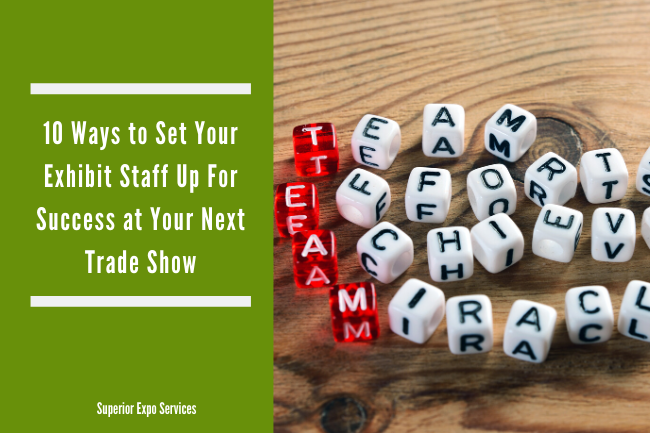Set Exhibit Staff Up for Success With These 10 Tips

The large majority of what booth visitors will remember your company by long after the trade show is over, is based on the brief experiences they have with your booth staff. Making sure that your staff is trained for the high energy and uniquely different converting landscape of a trade show will ensure that your company is making the most of your investment. Here are 10 ways to set your exhibit staff up for success at your next trade show.
Start early.
Start selecting and training your booth staff at least 3 months before the show. If you attend multiple shows each year, keep training an ongoing thing and also consider adding it into any exisiting sales training that you have in place. It should be considered a mandatory training by management.
Set measurable goals.
You can’t achieve a goal you haven’t set and that isn’t measurable. Set your staff up for success by discussing your company’s measurable goals with them. For example, if you are launching a new prodcut, be sure that your staff feels comfortable enough to talk about it. Be specific aboiut how many demos your staff should perform. If you’re holding existing client meetings, have your staff up to date on what they are already using and what the goal of each meeting is i.e. is there a new product to discuss, a continuation of an existing contract, etc? And if you’re looking to engage with new prospects, what will the daily number of contacts to engage with in order to convert to the desired number of prospects?
Practice.
Have role-playing opportunities for your staffs to practice different kinds of conversations and pitches depending on the feedback they get from the visitor. Keep them focused on the short, quick conversations and energy of the floor so that they can “churn and burn” so to speak. It’s a totally different dynamic and important to keep that in mind when training.
Keep them motivated.
During the show, keep track of your staff’s achievements and recognize them for it. Hand out money, coffee, ensure they’re getting their breaks and able to hit the energetic reset button. Be sure to give them feedback during the event and be open to theirs as well. If they are the ones doing the majority of engaging and they have a suggestion, listen.
Keep the show’s goals in priority.
Your staff should know to engage in and focus on behavior that helps them achieve the goals you’ve set. They should be available to chat with any attendee that visits your booth, and in a timely fashion. They’re not there to chat with each other or neighbor exhibitors. There’s finite time to engage and minutes count in this environment.
Focus on conversion.
Whether you’re looking to present demos, set up client or prospect meetings, or sell something in the booth, your company has a conversion process to get there. Your staff should be thinking in terms of engaging, qualifying, discovering (and understanding where they are in the buyer’s journey), presenting and closing with next steps, all in about a 10 minute timeframe, generally speaking. If it goes longer and your prospect has the time, great. But again, keeping your exhibit staff in the mindset of the hustle and bustle of the show floor will help to take advantage of the opportunity to engage with as many people as possible.
Know when to disengage.
This is just as important as knowing when to engage. If your staff learns that a visitor is not a qualified prospects for your business, they should know how to disengage professionally and rather quickly, before allowing other potential qualified prospects to walk on by. This should most definitely be part of your role-playing tactics.
Ready to slay the day.
Your exhibit staff should have clear guidelines for their appearance and wardrobe and it should reflect your company’s image. Discussing ahead of time if you’ll be in formal vs. casual wear, wearing coordinated shirts, your policy on tattoos and/or piercings is all important to ensure everyone’s on the same page.
Be present.
When your staff is in the booth, they should be in GO mode. No eating, checking emails on their phone, etc. We know that it can be hard after a long couple days to enforce this, but it’s important. Prospects may hesitate to approach you or your booth is someone’s busy checking their phone or munching on a sandwich. If someone needs a break, they should ensure they’re covered, and then go do that they need to do.
Set expectations for follow-through.
This is SO important. And we like to say follow-through because there’s nothing worse than talking about a follow-up and then not doing it. Your booth staff should know what the next steps are in your process, make good notes, even if on the back of their business card. Then based on each prospect and what makes sense, communicate next steps clearly so they know what to expect.
Once you get to the show, add power to your training with pre-show meetings or even rallies. Get everyone excited! Talk about your goals and how it will benefit everyone in the company if they are hit! Research shows that very little of the money spent on trade shows is spent on setting staffs up for success with training, but the engagements your staffs make with booth visitors makes up the largest majority of what people will remember your company by.
